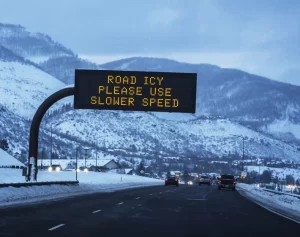Be Prepared for Winter Driving!
Get Ahead of the Game! How to Maintain your Vehicle for Winter Conditions
It’s important to keep your vehicle maintained year-round to minimize the chances of a break-down, here are some tips that are especially important come inclement weather.
- Test your battery! – Summer and winter time is the hardest on your battery. However, in the cold weather, battery power drops, requiring more starting power to get your vehicle running.
- Check all fluids, especially the coolant – Having all fluids at the right level in good condition can help keep your vehicle running in tip-top shape to avoid complications on the road. It is especially important to ensure that your coolant tests to a protection level of -34°F to prevent freezing and subsequent engine damage.
- Check your washer system! Ensure that you have winter protected washer fluid to avoid freezing, as well as making sure your windshield wipers are not streaking and effectively cleaning the windshield.
- Check the belts and hoses of your vehicle for any signs of wear – These components often give little to no obvious warning signs of failure when driving and could leave you stranded anytime of the year. However, it is especially aggravating when stranded in the bitter cold.
- Check your tires! – Colorado Mountain Traction Law states that tires must be at 6/32nds of an inch tread depth or higher. It is also recommended to run a set of high-quality winter tires during the colder months, and all season tires during the summer. Finally, when the temperature outside is changing so frequently, it is important to check your tire for proper inflation because 10°F can change you tire pressure by about 1psi.
- Keep your fuel tank full! In the wintertime your fuel lines and tank are prone to getting condensation, and if that condensation freezes you could be looking at a costly and preventable repair. In addition to preventing unnecessary repairs, should you get stuck, you want to ensure you have enough gas to keep the car running and yourself warm.
- Check the A/C system! For the same reason you want to keep your fuel tank full to avoid condensation concerns, the interior of your car is also prone to excessive condensation build up. By running your A/C system in the winter (i.e. turning on the defroster) you are removing some of the moisture that is in the air, preventing poor visibility due to foggy windows.
- Pack an emergency kit! A few good items to keep in an emergency kit is sand or kitty litter for traction, an ice scraper, jumper cables/box, gloves, hat, blanket, 1st aid kit, shovel, flashlight, extra batteries, paper towels, warning device such as a popup cone or high visibility triangle, water bottles and non-perishable snacks.
Tips For Driving in Bad Weather
- Do not use cruise control – If you hit an icy patch and lose traction, your cruise control management system can not tell the difference between a slipping wheel and speeding up wheel and will try to adjust your speed potentially causing you to lose control of the vehicle and crash.
- Drive slower – You and the cars around you can lose traction or control of the vehicle at any time, so you’ll want to give yourself the most amount of time and space possible to react and avoid an accident. Remember, 4×4 or AWD doesn’t mean 4-wheel STOP!
- Increase following distance – Slick roads require more stopping distance, it is advised to leave an 8-10 second delay between you and the car in front of you.
- Don’t stop if you can avoid it – The best way to avoid getting stuck in the snow with no traction is to be continually moving and maintaining traction. Once your tires completely stop on an ice patch, they will just continue to slip and roll on the ice rather than rolling over the ice with the momentum you already have.
- Don’t power up hills or stop on hills – Trying to power up a hill will only cause your tires to spin faster and potentially lose traction. It is advised to begin speeding up for the hill prior to the base of the hill so you can maintain the same momentum and traction. For similar reasons of maintaining traction, it is advised to not stop on a hill whenever feasible because it may be near impossible to get moving again on a hill.
- Check the weather – Checking the weather can help you determine if the road conditions will be icy, snow packed, etc. and help you determine how much additional time you need to get to your destination.
- Check your route – It is advised to check your route before driving to avoid areas that already have multi-vehicle accidents or any road closures to minimize the time you are spending on the road.
- Leave extra time to get to your destination – Everyone on the road should and will be driving slower with longer distances between each car. Naturally, when the traffic pattern is slower, it will take you additional time to get your destination.
- Steer into the direction of the skid – Steering into the direction of the skid will help you when you regain traction to not find yourself overcorrecting to stay in your lane.
- If you find yourself in a multi-car accident, stay in your car – It is safer to stay inside of your vehicle than to be exposed to additional oncoming cars.

If you have any questions on how to properly prepare yourself and your vehicle for winter driving, Seyfer Automotive is here to help all our neighbors in the Wheat Ridge, Golden, Lakewood, Arvada, and surrounding Denver neighborhoods. Call us at (303) 422-5261 to schedule your appointment for a winter driving inspection.

